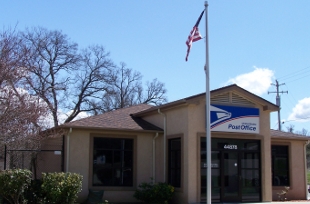Ahwahnee is a small, unincorporated rural town about five miles northwest of Oakhurst on Highway 49. Situated at the southern end of California’s Gold Rush Country, Ahwahnee was first populated by immigrants who set about providing the miners with essential goods and services needed in their pursuit of gold.
The name “Ahwahnee” is derived from the Yosemite Indian Tribe, Southern Sierra Miwok word awwo that, in English, means “mouth.” As they saw the Yosemite Valley as being shaped like a huge mouth, they called it Ahwahnee; and as the people of the Ahwahnee, they were called the Ahwahneechee. Ahwahnee the town was reportedly once called Wassama as well.
Though small in size, Ahwahnee has had a grand history as a way station on Washburn’s stage line route to Yosemite National Park. President Theodore Roosevelt, Susan B. Anthony, the Crown Prince of Belgium, Andrew Carnegie, John D. Rockefeller, Rube Goldberg and other notable travelers are all reported to have stopped for lunch at the Ahwahnee Tavern dining hall.
In 1919 construction began on the tuberculosis sanatorium at the tavern site. William Sell sold the property when the tavern was bypassed, both by a modern highway to the Yosemite Valley and the railroad to El Portal. The sanatorium started with two buildings but grew to include three units, two wards, a nurse’s home, recreation hall, homes for two physicians, a separate building for child patients, a school, a laundry, many barns and shops and several cottages for employees. It also included a herd of registered dairy cattle.
When the sanatorium closed, it became a boy’s home, which operated into the mid 1980’s before it was closed down. The site is now designated to become Ahwahnee Hills Regional Park. Deconstruction and renovation of some of the buildings has begun, with new construction of walkways, horse trails, an equestrian center, pentanque courts, a cultural center and walking paths underway. The Park is slated to officially open in 2012.
The community of Ahwahnee will likely continue to adapt to changing times as the hearty folks of the area often do. Travelers from Merced and the San Joaquin Valley continue to pass through this town on their way to Yosemite National Park, Bass Lake or any of the other attractions and visitor destinations for which our area is famous.
Today, Ahwahnee is a peaceful small community with a population of approximately 1,680 residents who strive to maintain their rural atmosphere. It has several small lodging establishments, a restaurant and bar, a school, fire department, an eighteen-hole golf course, and is the site of the Wassama Roundhouse, one of the historic sites which visitors to the area currently stop to explore.
Wassama Roundhouse
 The Wassama Roundhouse is a local Historic Ceremonial Miwok site, and the focal point of the Wassama Roundhouse State Historic Park in Ahwahnee. It is one of only a few remaining roundhouses in California, and is still in use today as a ceremonial structure.
The Wassama Roundhouse is a local Historic Ceremonial Miwok site, and the focal point of the Wassama Roundhouse State Historic Park in Ahwahnee. It is one of only a few remaining roundhouses in California, and is still in use today as a ceremonial structure.
As part of the State Parks System, The Roundhouse Park is operated by the Wassama Roundhouse Association under the supervision of local Miwok Tribal members. Tribal ceremonies are traditionally held at harvests, births and for mourning ceremonies. Special events and tours are available, but ceremonies are strictly for Tribal Members only. The Indian Gathering Day, including cultural dance demonstrations, crafts and basket weaving, is held the second Saturday in July each year, and is open to the public.
For more information about the Wassama Roundhouse Association, write to P. O. Box 328, Ahwahnee, CA 93601, or call (559) 683-8194.




